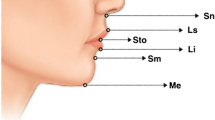Abstract
Four vertical and three horizontal measurements were taken to assess the validity of neoclassical facial canons in 500 (272 female, 228 male) healthy, young adults between the ages of 18 and 25 years from Turkey and to compare them with a different population. The measurements were made by a millimetric compass. The special head height was longer than the special face height in the majority of our group (women/men: 97.8%/91.7%). The three-section facial profile canon was equal in only one male subject (women/men: 0/0.4%). Faces with four equal profile sections were not seen in either of the sexes. The nose length was longer than the ear length in the minority of our population (women/men: 1.5%/1.3%). The intercanthal distance was shorter than the nose width and left eye fissure length in the majority of our subjects (women/men: 50.4%/78.9% and 50.0%/52.2% respectively). The mouth width was greater than 1.5 times the nose width in the majority of this study (women/men: 66.9% vs 49.1%).


Similar content being viewed by others
References
Bergmüller JG (1723) Anthropometria. JJ Lotter, Augsburg
Bishara SE, Hession TJ, Peterson LC (1985) Longitudinal soft-tissue profile changes: a study of three analyses. Am J Orthod 88: 209
Bush K, Antonyshyn O (1996) Three-dimensional facial anthropometry using a laser surface scanner: validation of the technique. Plast Reconstr Surg 98: 226
Da Vinci L (1786) Trattario della pittura. Bologna. Quoted by Boyd E (ed) (1980) Origins of the study human growth. University of Oregon Health Sciences Center Foundation, Portland, p 167
Dawei W, Guozheng Q, Mingli Z, Farkas LG (1997) Differences in horizontal neoclassical facial canons in Chinese (Han) and North American Caucasian populations. Aesth Plast Surg 21: 265–269
Dürer A (1557) Les quatre livres d’Albert Dürer, peintre et géomètre très excellent, de la proportion des parties portraits des corps humains. C Perier, Paris
Elsholtz JS (1663) Anthropometria. A Becman, Frankfurt am Oder
Farkas LG, Hreczko TA, Kolar JC, Munro IR, Chir B (1985) Vertical and horizontal proportions of the face in young adult North American Caucasians: revision of neoclassical canons. Plast Reconstr Surg 75: 328–337
Farkas LG, Munro IR, Chir B, Kolar JC (1985) Abnormal measurements and disproportions in the face of Down’s syndrome patients: preliminary report of an anthropometric study. Plast Reconstr Surg 75: 159–167
Farkas LG (1987) Age and sex-related changes in facial proportions. In: Farkas LG, Munro IR (eds) Anthropometric facial proportions in medicine. CC Thomas, Springfield, pp 29–56
Farkas LG, Kolar JC (1987) Anthropometrics and art in the aesthetics of women’s faces. Clin Plast Surg 14: 599–616
Farkas LG (1996) Accuracy of anthropometric measurements: past, present and future. Cleft Palate Craniofac J 33: 10
Farkas LG, Forrest CR, Litsas L (2000) Revision of neoclassical facial canons in young adult Afro-Americans. Aesth Plast Surg 24: 179–184
Farkas LG, Katic MJ, Forrest CR (2002) Surface anatomy of the face in Down’s syndrome: age-related changes of anthropometric proportions in the craniofacial regions. J Craniofac Surg 13: 368–74
Ferrario VF, Sforza C, Poggio CE, Serrao G (1996) Facial three-dimensional morphometry. Am J Orthodont Dentofac Orthop 109:86–93
Ferrario VF, Sforza C, Colombo A, Schmitz JH, Miani A, Serrao G (1998) A three-dimensional computerized mesh diagram analysis and its application in soft tissue facial morphometry. Am J Orthod Dentofac Orthop 114: 404–413
Ferrario VF, Sforza C, Colombo A, Poggio CE, Schmitz JH (1999) Soft-tissue facial morphometry from 6 years to adulthood: a three-dimensional growth study using a new modeling. Plast Reconstr Surg 103: 768–778
Ferrario VF, Sforza C, Colombo A, Serrao G, Colombo A, Ciusa V (1999) Soft-tissue facial growth and development as assessed by the three-dimensional computerized mesh diagram analysis. Am J Orthod Dentofac Orthop 116: 215–226
Ferrario VF, Sforza C, Colombo A, Schmitz JH, Serrao G (2001) Morphometry of the orbital region: a soft-tissue study from adolescence to mid-adulthood. Plast Reconstr Surg 108: 285–292, discussion 293
Kasai K, Richards LC, Brown T (1993) Comparative study of craniofacial morphology in Japanese and Australian aboriginal populations. Hum Biol 65: 821–834
Le TT, Farkas LG, Ngim RCK, Levin LS, Forrest CR (2002) Proportionality in Asian and North American Caucasian faces using neoclassical facial canons as criteria. Aesth Plast Surg 26: 64–69
Lehmann JA (1987) Soft-tissue manifestations of aesthetic defects of the jaws: diagnosis and treatment. Clin Plast Surg 14: 767–783
Mantzikos T (1998) Esthetic soft tissue profile preferences among the Japanese population. Am J Orthod Dentofac Orthop 114: 1-7
Miyajima K, McNamara JA, Kimura T, Murata S, Iizuka T (1996) Craniofacial structure of Japanese and European-American adults with normal occlusions and well-balanced faces. Am J Orthod Dentofac Orthop 110: 431–438
Moss JP, Linney AD, Grindrod SR, Arridge SR, Clifton JS (1987) Three-dimensional visualization of the face and skull using computerized tomography and laser scanning techniques. Eur J Orthod 9: 247
Porter JP, Olson KL (2001) Anthropometric facial analysis of the African American woman. Arch Facial Plast Surg 3: 191–197
Sim RS, Smith JD, Chan AS (2000) Comparison of the aesthetic facial proportions of southern Chinese and white women. Arch Facial Plast Surg 2: 113–120
Tolleth H (1984) Observations on form and proportion. In Hetter G (ed) Lipolysis: theory and practice. Little Brown, Boston
Tolleth H (1987) Concepts for the plastic surgeon from art and sculpture. Clin Plast Surg 14: 585–598
Vegter F, Hage JJ (2000) Clinical anthropometry and canons of the face in historical perspective. Plast Reconstr Surg 106: 1090–1096
Zingaro EA, Falces E (1987) Aesthetic anatomy of the non-Caucasian nose. Clin Plast Surg 14: 749–765
Zylinski CG, Nanda RS, Kapila S (1992) Analysis of soft-tissue facial profile in white males. Am J Orthod Dentofac Orthop 101: 514
Acknowledgement
We are grateful to Prof. Dr. Fahri Dere for his advice and for preparing the illustrations.
Author information
Authors and Affiliations
Corresponding author
Rights and permissions
About this article
Cite this article
Bozkir, M.G., Karakas, P. & Oguz, Ö. Vertical and horizontal neoclassical facial canons in Turkish young adults. Surg Radiol Anat 26, 212–219 (2004). https://doi.org/10.1007/s00276-003-0202-2
Received:
Accepted:
Published:
Issue Date:
DOI: https://doi.org/10.1007/s00276-003-0202-2




